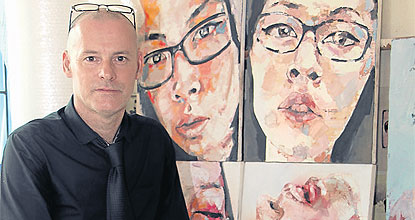Chon Buri-based British artist Thomas Donaldson’s debut solo exhibition is all about facial expressions. With a few exceptions of torso nudes, most of the collection are portraits of women whose expressions are portrayed by smudges and smears of paint.

Entitled “Where’s My Head”, Donaldson’s impasto technique seems to give the subjects bulging dimensions and life, and a certain expressive quality to their faces.
Whether you give yourself five minutes or five hours looking at them, you can never be quite sure just what these faces are trying to say. None of them are smiling, yet you can’t exactly say they are unhappy either. At times they seem to be staring blankly, while at others they are distracted, thoughtful or pensive.
In a recent interview with Life, Donaldson talked about the concept of his work and how his art has been influenced by popular culture, especially television and advertising.
Can you tell us a little bit about yourself?
I’m a British artist but have been living and working in Thailand for around eight years now. I’m currently based in Chon Buri, although I did spend a number of years working in Bangkok. I completed my Master of Fine Arts in 2000 at the University of Newcastle Upon Tyne, UK. After graduation I continued my painting practice and also began teaching. I am currently a full-time lecturer in the department of multimedia at the Asian University in Chon Buri.
How did this collection of works come about?
This collection came about through feeling dissatisfied with earlier works and also that I no longer wanted to create just an illustration of a figure or portrait, a copy or likeness of the model. I wanted to engage with the ‘matter’ or surface qualities of the painting, to make it an object, by building the layers of paint and making the physical qualities of the paint as important as the visual image.
What’s the main of concept?
The concept is derived from the process of painting the head/figure. In that the head is revealed or searched for through the application and dragging of paint. The works also acknowledge certain aspects of the existentialist premise that one cannot fully know or experience the reality of another person, and that this separateness underlies our daily consciousness. As most of the heads and figures are not anatomically complete, you only see a cropped section or vague shape of the portrait or figure.
Why did you use the “human figure” as a starting point for this series of works?
The figure is a traditional subject within the history of painting; it is easily recognisable, has been painted over and over again and we’re all familiar with the figure; our own and other peoples. This familiarity with the subject and notions of beauty allows me to develop the process through abstraction, mark-making and impasto and at the end still have something that remains familiar but slightly awkward.
How has your set of paintings been affected or influenced by popular cultural references on television and advertising media?
We live in a world where we are now subjected to countless images of Photoshopped perfection of portraits and bodies. So my paintings are hopefully a counter-balance to this through the use of uneven surface textures and blotches of paint. Creating a sort of imperfect or flawed beauty.
Can you explain a little bit about the techniques used in this series? Why the use of the human figure or head with abstract marking?
I use various techniques including thickly-applied impasto paint, dragging and smudging the paint surface plus the occasional intervention of a ‘happy accident’ or chance. All these abstract traits contribute in the process of making or constructing a painting. Although the works are representational and figurative they intend to suggest, rather than depict an accurate observation of the subject. This is more apparent as the viewer approaches the work and the painted surface dissolves into a seemingly unorganised and abstract arrangement of blotches and irregular textures resembling abstract paintings.
“Where’s My Head” is on display until April 30 at La Lanta Fine Art, 245/14 Sukhumvit Soi 31.

Thomas Donaldson.


